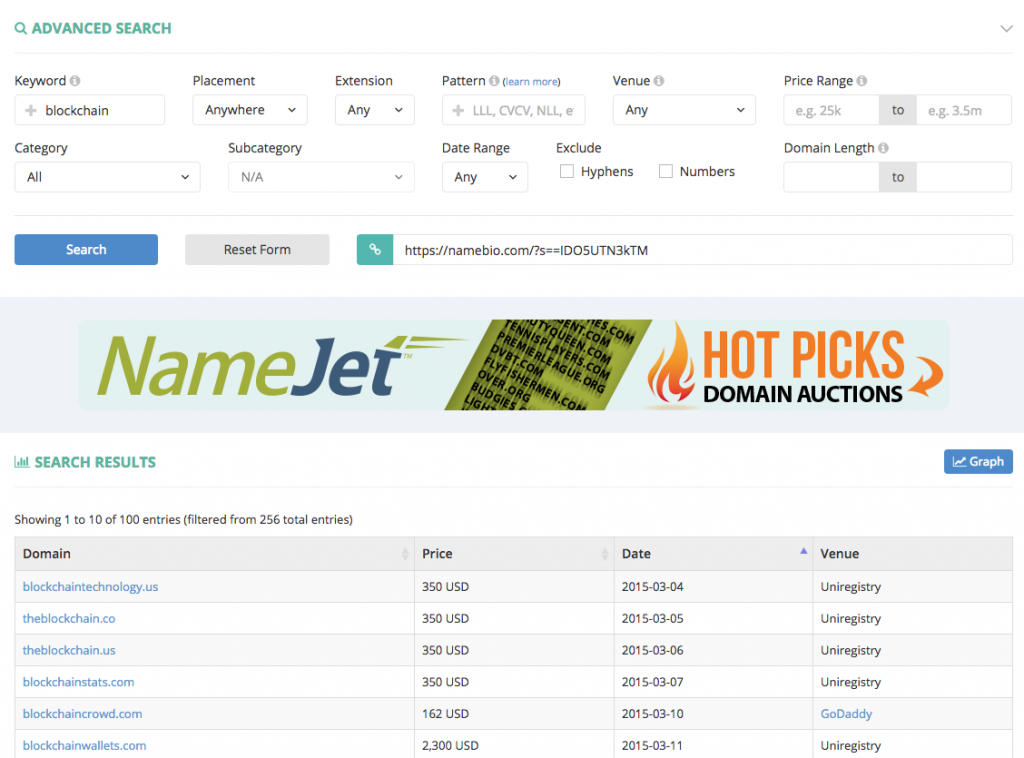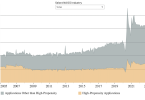One key to success in domain name investing is to know the types of domain names that have sold previously for good prices. Sales prices of comparable names that sold previously is important intelligence for both buyers and sellers of domain names.
We are fortunate that a huge database of domain name sales information is publicly accessible as NameBio. While not all sales are reported to NameBio, so you have to be sensitive to biases that may introduce, the database is a highly respected and widely used resource within the domain community.
In this first post in the series we provide a basic introduction to using the NameBio database. This is intended primarily for those who have not used NameBio previously, although even seasoned domain investors may pick up a tip or two.
We cover in this post how to do a basic search, narrow the price range or sales venue, look for exact match domain sales, and look at sales with specific niches.
In future posts in the series we will look at techniques for more sophisticated searches including compound words, trends, domain hacks, letter-number patterns and more.
What Is NameBio?
The NameBio database was developed by Michael Sumner and his associates. You can read about Michael and how NameBio came about in this interview at TheDomains.
The NameBio database is updated daily (normally at midnight in the eastern time zone) with new sales data. It covers sales in all domain extensions, and at all prices above $100. Inclusion in the database requires verification of the sale unless it is through an authorized site (such as one of the major domain auction houses).
At time of writing the NameBio database contains over 642,000 domain sales accounting for a total of more than $1.7 billion sales volume. While the earliest sales listed are from 1997, the database is less complete in representing domain name sales from the early years.
What is Included?
While they collect data on lower value sales from some venues, only sales in excess of $100 USD are publicly reported through the database.
The venues that report to the database have varied somewhat over the years, but publicly reported sales currently include 4.cn, Bido, BuyDomains, DropCatch, Dynadot, Fabulous, Flippa, GoDaddy auctions, NameJet, ParkIO and Sedo. A variety of other venues, including some of the registries with premium domain sales, periodically report. Michael has written in detail about what is in the database in this informative post at NamePros.
Note that sales from Afternic, Efty sites, Undeveloped and non-auction Sedo sales less than $2000 are not normally included unless one party to the transaction manually report them. Some estimate that the database represents about 20% of total domain aftermarket sales.
How to Search
Let’s say you want to know what domain names have sold in the blockchain niche. Here are the simple steps.
- Go to https://namebio.com/. The site is free and no registration is required.
- Enter the word ‘blockchain’ in the keyword box and then press the blue Search button.
- By default that will yield any words that contain the search term anywhere with any price, venue or extension. If you scroll the search results (see graphic) it will above the list show you how many results it found (256 in this case). If you scroll a bit further the stats section will show you the minimum, maximum and average prices.
- Note that the list can be ordered by price or date, ascending or descending. Simply press on either the Price or the Date title to do this (pressing again switches from descending to ascending).
- You will see that most of our ‘blockchain’ search results are multiple words one of which is blockchain. What if I wanted only the word blockchain? In that case use the Exact setting in the Placement control. Press the Search button again. When I do that today it shows only 9 sales of the exact word ‘blockchain’, the largest of which was blockchain.ventures that sold for $42,000.
- Note that you can similarly use the Placement control to find sales where the domain name is only at the beginning or ending of the domain name. As we will see in a future post, this can be very useful when evaluating compound two or three word domain names.

In the following sections we indicate how to restrict your search to certain extensions, sales venues, price ranges or subject categories.
Limiting To Certain Extensions
Let’s say you are interested in how many times .org extension domain names sold in the past year. This is readily answered (at least to the degree that NameBio represents all domain sales) by entering nothing in the Keyword search box, and also leave the default any in the Placement control, but select the .org extension option from the Extension control. Under the Date control select ‘past year’, and then press the Search button. I show that search in the figure below.

The database allows searches on the past few individual days by date, the past week, month, or year, or individually each off the last three years including the current year to date. You can also search the past 5 years or all time.
Looking At Certain Venues
It is easy to look at sales only from a certain venue. Let’s say you are interested only in .com extension domain sales that took place at Sedo. Simply select using the Venue and Extension controls, and press the Search button. You can, if desired, have several venues checked simultaneously.
Price Ranges
You can combine price ranges with any of the other criteria. Let’s say you are interested only in sales between $400 and $25,000. Simply enter in the Price Range control 400 in the left hand box and 25k (which means $25,000) in the right hand box, and press search. I show the diagram the settings for searching in that price range for all .com sales during the past five years.

If you want only domain names up to a certain price value enter that in the right hand box (leaving the left box empty), or if you want only prices starting at some level and above enter the starting price in the left box, leaving the right side empty.
Categories
One of the best features of NameBio is the ability to search for sales in specific categories. For example if you under the Category button select Business and then under Subcategory select Biotechnology and Pharmaceuticals, and then press search (adding any other specifications such as extension, price, venue or date if desired), you obtain only those domain sales that are in the biotechnology and pharmacy area.

I find that the categorization is not perfect, so you should scroll through the results, but it does a pretty good job. For example, it showed DomainInvestment.com in the biotechnology results. I think this is because the word ‘domain’ does have meaning and wide use in biology, but I suspect this particular domain name was not purchased for this use (it is currently parked and for sale, so I guess we don’t know for sure).
It will take you a little while to get used to the categories and subcategories. For example, if looking for fitness domain names I might have thought it would be under Recreation but it is actually a subcategory Fitness under the main category Health. If looking for crypto domains you go to Other as the main category and then Crypto Domains subcategory.
Future Posts
We will continue this in future posts at NameTalent with more sophisticated NameBio search techniques. Our next post will look at how to do searches for comparators for multi-word domain names and to use NameBio to look at trends. The third post in the series will look at methods for finding character or number sequences. After that we will show how NameBio can be used for domain hacks.
Keep in Mind
It is important to keep in mind that as powerful as NameBio is, it does not represent all domain sales. By excluding low value Sedo sales and sales from sites such as Afternic, Undeveloped and Efty, NameBio may introduce significant biases. Also, some new extension registries regularly report, while many others never report, and a few report on an irregular and incomplete basis.
It is important also to remember that NameBio really is a mix of two price distributions, one for retail sales (to end users who will use the domain name in a business or organization) while others are wholesale prices (one domain investor selling to another).





Thank you Bob, great piece! Looking forward at the next series.
[…] in mind that only certain venues report sales to NameBio, and that some sales are put in the database too late to make the daily reports. The reporting […]
[…] majority of sales of ngTLDs are at Undeveloped, Efty sites, and various registrar marketplaces, and therefore not reported to NameBio. […]
[…] to end user) sales. The median sales price should be interpreted within that understanding. In my introductory guide to using NameBio I provide additional details on what sales are included in the database. […]
[…] to end user) sales. The median sales price should be interpreted within that understanding. In my introductory guide to using NameBio I provide additional details on what sales are included in the database. […]
[…] to end user) sales. The median sales price should be interpreted within that understanding. In my introductory guide to using NameBio I provide additional details on what sales are included in the database. […]
[…] to end user) sales. The median sales price should be interpreted within that understanding. In my introductory guide to using NameBio I provide additional details on what sales are included in the database. […]
[…] to end user) sales. The median sales price should be interpreted within that understanding. In my introductory guide to using NameBio I provide additional details on what sales are included in the database. […]
[…] to end user) sales. The median sales price should be interpreted within that understanding. In my introductory guide to using NameBio I provide additional details on what sales are included in the database. […]
[…] to end user) sales. The median sales price should be interpreted within that understanding. In my introductory guide to using NameBio I provide additional details on what sales are included in the database. […]
[…] to end user) sales. The median sales price should be interpreted within that understanding. In my introductory guide to using NameBio I provide additional details on what sales are included in the database. […]
[…] to end user) sales. The median sales price should be interpreted within that understanding. In my introductory guide to using NameBio I provide additional details on what sales are included in the database. […]
[…] to end user) sales. The median sales price should be interpreted within that understanding. In my introductory guide to using NameBio I provide additional details on what sales are included in the database. […]
[…] to end user) sales. The median sales price should be interpreted within that understanding. In my introductory guide to using NameBio I provide additional details on what sales are included in the database. […]
[…] to end user) sales. The median sales price should be interpreted within that understanding. In my introductory guide to using NameBio I provide additional details on what sales are included in the database. […]
[…] to end user) sales. The median sales price should be interpreted within that understanding. In my introductory guide to using NameBio I provide additional details on what sales are included in the database. […]
[…] to end user) sales. The median sales price should be interpreted within that understanding. In my introductory guide to using NameBio I provide additional details on what sales are included in the database. […]
[…] to end user) sales. The median sales price should be interpreted within that understanding. In my introductory guide to using NameBio I provide additional details on what sales are included in the […]
[…] to end user) sales. The median sales price should be interpreted within that understanding. In my introductory guide to using NameBio I provide additional details on what sales are included in the […]
[…] to end user) sales. The median sales price should be interpreted within that understanding. In my introductory guide to using NameBio I provide additional details on what sales are included in the […]
[…] to end user) sales. The median sales price should be interpreted within that understanding. In my introductory guide to using NameBio I provide additional details on what sales are included in the […]
[…] to end user) sales. The median sales price should be interpreted within that understanding. In my introductory guide to using NameBio I provide additional details on what sales are included in the […]